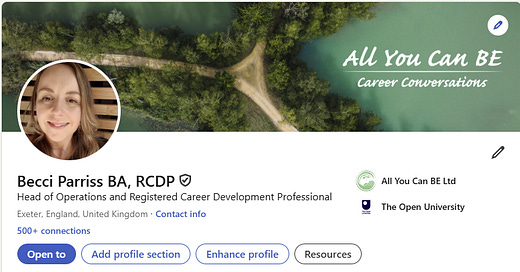Seven reasons why you need a LinkedIn profile
Hate social media? Me too, but when approached correctly, it can make all the difference in your job search.
Like a certain military male in my life, you might recoil at the thought of having to create any kind of social media presence, but when it comes to finding your next career move, LinkedIn can make your job search infinitely easier.
I’m not going to tell you how to create the perfect profile, firstly because I don’t believe such a thing exists and secondly, every man and his dog has already written this down in various forms (I’ve listed a few great ones to read at the end of this post). What I want to explain is why it is so useful and how you can control how you interact with it to ensure you’re as comfortable as possible.
Everybody else is on it: There are more than 42 million UK users on LinkedIn so it’s no wonder that it has become an integral part of the professional culture. When a person enters your radar - whether as a job applicant, somebody you meet while networking or somebody recommended to you - the first instinct for many is to look that person up on LinkedIn.
Recruiters rely on it: 72% of recruiters use LinkedIn as their primary recruiting tool. When a recruiter has a vacancy to fill, they aren’t just waiting for applications to arrive, they are actively seeking potential candidates who fulfil the job description. They will search LinkedIn using keywords, locations and previous employers to seek out the people they want.
It’s annoying for recruiters when you’re not: We discussed in understanding how your CV is processed the amount of time a recruiter is likely to spend looking at your application and how you can improve your chances of success when you help them out by making the information they’re looking for easy to find. The recruiter may look you up on LinkedIn for a number of reasons, including to answer small questions they may have about your current circumstances or work history which could make a difference to the progress of your application. When they can’t find you, it’s gone from a ‘quick check’ to needing to call or email you or even worse, just moving on to the next applicant.
It’s a ready-made extended network: Loads of people you know will already be on LinkedIn and when you join, it makes it significantly easier for them to introduce you to their connections. The culture of the platform allows you to be direct in what you’re looking for and enables you to reach your contact’s contacts without them needing to lift a finger.
You can use it to do your own research on people and companies: This isn’t just about people being able to see you, you can also use LinkedIn to do your own research. Been invited to an interview? You can look up your interviewer to get an idea of their personality and background, opportunity sound too good to be true? Look up the organisation and see what their staff turnover and culture is like.
You can set your own boundaries: There is nothing that you have to do on LinkedIn; you can post as little or often as you like, you can show your face in your profile picture or have a more obscure image, the important thing is that your profile is there, is up to date and has the basic information your connection or potential employer is looking for. This cheat sheet from LinkedIn for Dummies is great!
You can help your network: It feels good to help other people and when you take the time to look at what your connections are looking for, it’s inevitable that there will be situations where you can add value, either through an introduction, recommendation or simply sharing your own experience. Not only will this give you a warm and fuzzy feeling for helping another human, it will also strengthen your professional relationships and draw your network’s attention to you.
Resources
Here are some great resources to get you started with your profile:
LinkedIn Help pages have some brilliant in-depth resources





